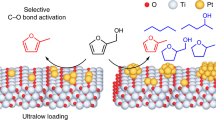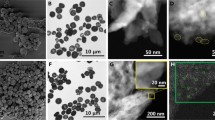Summary
-
1.
Catalysts with atoms that do not have the necessary number of free valences in the ground valence state to produce a desired reaction have to be activated. The activation may be achieved by thermal energy. If the temperature is raised, part of the catalyst atoms go over into various excited valence states.
-
2.
The most probable way for the activation of a metallic catalyst to go, leading directly to the formation of an active center, is to break the cohesional M-M bond.
Similar content being viewed by others
Literature cited
L. Pauling, Phys. Rev.,54, 899 (1938).
L. Pauling, J. Amer. Chem. Soc.,69, 542 (1947).
L. Pauling, Proc. Roy. Soc. A196, 343 (1949).
R. J. Weiss, and J. J. de Marco, Rev. Mod. Phys.,30, 59 (1958).
N. F. Mott, and H. Jones, Properties of Metals and Alloys, Oxford University Press, L., 1936.
G. G. Bond and R. S. Mann, J. Chem. Soc., 1959, 3567.
O. Beeck, Disc. Faraday Soc.,8, 118 (1950).
M. Boudart, J. Amer. Chem. Soc.,72, 1040 (1950).
G. K. Boreskov, Zh. fiz. khimii31, 937 (1957).
M. Becker and G. Jenkins, Catalysis. Electronic Phenomena [Russian translation] IL, M., 1958, p. 7.
D. A. Dowden, J. Chem. Soc., 1950,242.
P. W. Reynolds, Chemistry and Industry, 1949, 320.
A. Couper and D. D. Eley, Disc. Faraday Soc.,8, 172 (1950).
G. M. Schwab, Trans. Faraday Soc.,42, 689 (1946).
M. A. Landau and V. V. Shchekin, Izv. AN SSSR. Otd. khim. n. 1961, 430.
M. A. Landau and V. V. Shchekin, Trudy Instituta nefti AN SSSR14, 118 (1960).
M. I. Temkin and L. O. Apel'baum, Problems in Physical Chemistry (Transactions of the L. Ya. Karpov Scientific Research Physical Chemical Institute) [in Russian] No. 1, 1958, p. 94.
M. I. Temkin and L. O. Apel'baum, Problems in Kinetics and Catalysis, X. Physics and Physical Chemistry of Gatalysis [in Russian] Academy of Sciences Press USSR M., 1960, p. 392.
G. K. Boreskov, Problems in Kinetics and Catalysis, X. Physics and Physical Chemistry of Catalysis [in Russian] Academy of Sciences Press, USSR, M. 1960, p. 128.
G. M. Shvab, Catalysis from the Point of View of Chemical Kinetics [in Russian] (ONTI, State Chemistry Press, L., 1934,p. 146.
G. M. Panchenkov and V. P. Lebedev, Chemical Kinetics and Catalysis, [in Russian] M. V. Lomonosov Moscow State University Press, M., 1961, p. 341.
Author information
Authors and Affiliations
Additional information
The authors wish to use this occasion to express their profound gratitude to Yu. P. Simanov, E. G. Treshchova, G. B. Sergeev, and Yu. I. Derbentsov, who aided in the solution of a number of problems.
Rights and permissions
About this article
Cite this article
Landau, M.A. Activation of metallic catalysts. Russ Chem Bull 11, 536–539 (1962). https://doi.org/10.1007/BF00904748
Received:
Issue Date:
DOI: https://doi.org/10.1007/BF00904748




